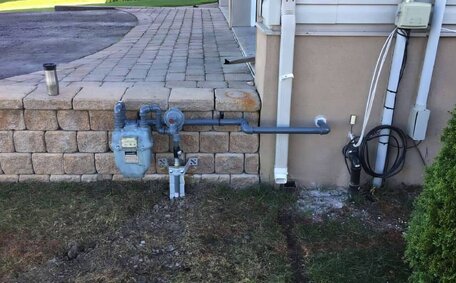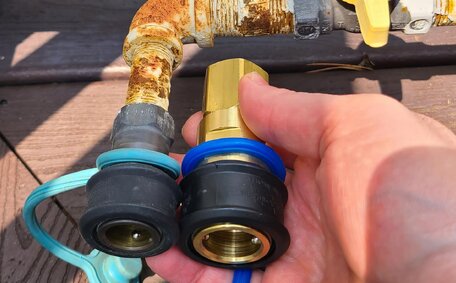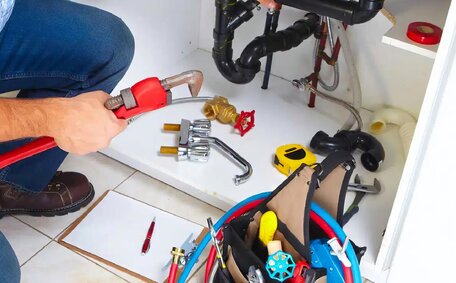What is Pipe Relining?
Pipe relining, known as Cured-In-Place Pipelining (CIPP), repairs pipes without digging by inserting a resin-coated liner into the damaged pipeline that cures to form a new pipe inside the old one.
Pipe relining provides a durable and cost-effective alternative to traditional pipe replacement.
Understanding the benefits of pipe relining can guide sound maintenance decisions:
- Minimally invasive - Pipe relining requires minimal excavation and yard disruption compared to traditional methods
- Faster repairs can be carried out speedily, with a turnaround time of mere hours or days as opposed to extensive weeks
- Improved flow - Relined pipes resist buildup, fixing damaged and blocked pipes efficiently
- Extended lifespan - Liners have a life expectancy of over 50 years, preventing future pipe damage
- Cost savings - Generally 50-60% less expensive than pipe replacement
Various pipe relining techniques like pull-in-place, inversion, and slip lining cater to different damage types. The right approach for rejuvenating your damaged pipes within existing frameworks depends on the type and extent damage encountered. Pipe relining technology is an efficient way to restore old pipes with a durable lining, avoiding the hassle and cost of excavation.
How Pipe Relining Works
The typical pipe relining process involves the insertion of a resin-coated liner which effectively rehabilitates the pipe. This liner is selected for its ability to seamlessly adhere to the pipe’s interior; it’s inflated and cured using hot water, steam, UV light, or ambient temperature to harden the resin. As it cures, the liner bonds to the inner walls of the pipe, forming a smooth, jointless 'pipe within a pipe’.
In the event of blocked drains, epoxy resins, combined with a hardening agent or catalyst, are commonly used. Upon combining, these materials form a hard plastic that lines the pipe’s interior, eliminating the need to dig up the yard. The resin-saturated liner, efficient in repairing damaged sections, closely conforms to the original pipe, minimising diameter reduction.
A significant advantage of pipe relining is its suitability for any plumbing situation, allowing new pipe lining even in hard-to-reach areas. The flexible liner, used for pipe repairs, is inserted through an existing access point and guided through the damaged area using a CCTV camera. Pipe relining eliminates the need for trenches and prevents damage to walls, floors, and gardens.
After curing, the epoxy liner restores structural strength and fluid flow, providing an effective solution for drain repair issues. The result is a cost-effective fix that significantly extends the lifespan of your drain pipes without invasive digging.
Traditional Pipe Repair vs Pipe Relining
Key differences include:
- Pipe relining preserves yards, trees, walls, floors - no destruction needed to access pipes
- Much faster process - pipe relining takes just hours or days vs. weeks of digging
- Reduced labour - Pipe relining makes excavation and repaving largely unnecessary.
- Lower costs - pipe relining averages 50-60% less than replacement
- Long lifespan - relined pipes, being strong durable, last over 50 years and are four times stronger than PVC
Pipe relining offers efficient, less disruptive, and cost-effective repairs, making it a superior alternative to the extensive process of traditional pipe replacement.
Key differences include:
Types of Pipes Suitable for Relining
Pipe relining technology is versatile and can repair a wide range of pipe materials:
- PVC - One of the most common pipe types within your plumbing system.
- Cast iron - Used as sewer pipe materials, these pipes are prone to rust and corrosion over time.
- Concrete or clay - Older pipes made from earthenware materials.
- Steel - Often found in commercial plumbing and municipal sewer mains.
- Copper - Used for water supply lines, copper pipes can develop pinhole leaks.
The fundamental requirement ensures the pipe can relined to structurally support a new pipe-within-a-pipe after relining. Pipe structures that are intact enough to allow for the support of a liner can be relined, providing a renewed lease on life for the plumbing system.
While materials such as galvanised steel may not be suitable, many common pipe types can be relined effectively using epoxy resins. Expert plumbing services can have your pipe inspected and advise if it can be relined, representing an appropriate choice for many situations.
Cured-in-Place Pipe Lining
Cured-in-place pipe (CIPP) lining is one of the most common and effective methods of pipe relining. It involves inserting a resin-impregnated felt liner into the damaged pipe and curing it in place to form a new, jointless pipe lining.
The CIPP liner is saturated with a thermoset resin like epoxy or polyester. It is fed through an existing access point on the pipe, like a manhole, using an inversion process. Pressurised air or water inflates the liner until it moulds to the inner walls of the damaged pipe.
Once in position, the process of how the liner is cured in place becomes apparent as agents like hot water steam or other methodologies like UV light solidify the resin. The resin binds to the host pipe creating a sturdy, jointless structure inside the existing passage.
CIPP liners are structurally strong and corrosion resistant. They reinstate integrity, flow efficiency, and the service life of deteriorated conduits, facilitating a lasting sewer repair without surgical replacement of pipes.
Cured-in-Place Pipe Lining
Pressurised air or water inflates the liner until it mouldsfibreglass that has been saturated with epoxy or polyester resin and inflated with compressed air.
One end of the liner is affixed to an inversion head or flange. Air or water pressure is then deployed to reverse the liner and propel it along the section pipe. The liner creates a new inner pipe as it unfolds and tightly moulds against the interior walls, forming a close fit.
Once in place, hot water or steam is pumped into the liner which activates and cures the resin into a hard, jointless pipe lining. When the curing is done right, the new liner remains in place as a pipe within a pipe.
Inversion relining, commonly used to repair extensive stretches of sewer stormwater pipes, is accessible from a single point. It can navigate bends and curves smoothly. Inversion relining can also ably manage storm water conduits, main sewer lines, and other large diameter pipes that sustain damage over time.
Pull-in-Place Relining
Pull-in-place relining is another trenchless pipe repair method. With this technique, a resin-impregnated felt liner is pulled into the damaged pipe through an access point. The liner’s diameter is slightly smaller than that of the original pipe to facilitate easy insertion.
Once the liner is pulled into position, it is inflated with steam or air pressure. The liner is then cured using hot water or steam which activates the resin.
Pull-in-place relining is effective for pipes with multiple bends or connections, offering a continuous liner that can navigate these obstructions for a seamless repair, and is suitable for pipes up to 12 inches in diameter.
No excavation is required as the flexible liner is pulled through the original pipe. When cured, it effectively creates a "pipe within a pipe" providing long-term structural renewal without digging or destruction.
Pull-in-Place Relining
Pull-in-place relining is another trenchless pipe repair method.
This process ensures that the liner bonds securely to the innating Relining
Brush coating relining is a manual technique, ideal for spot repairs or short sections of pipe, where a two-part epoxy resin is directly applied onto the pipe’s interior surface. Instead of using pre-coated liners, the two-part epoxy resin system is brushed dibetween pipes. The epoxy is applied using a rotating brush that thoroughly coats the interior of the pipe. It cures to form a corrosion-resistant barrier.
Benefits of brush coating, where repairs can done with utmost precision, include:
While not a whole-pipe solution, brush coating relining is a cost-effective option for sectional pipe repairs without the cost of full replacement.
Benefits of Pipe Relining
Opting for pipe relining over traditional replacement methods offers several advantages:
- Minimal disruption - No need to dig trenches or destroy landscaping. Relining is done from insertion points.
- Faster repairs - Pipe relining takes just hours or days compared to weeks for replacement.
- Cost savings - Pipe relining averages 50-60% less than full pipe replacement.
- Long lifespan - Epoxy liners can last 50+ years, longer than PVC pipe lifespan.
- Structural strength - Relined pipes offer a strength advantage and are often considered to provide the best pipe relining materials better than traditional options like PVC.
- Increased flow rate - The smooth epoxy lining reduces buildup and blockages, facilitating better drainage.
- All types of pipes, including those made from cast iron, clay, and concrete, can be relined effectively.
- Permanent solution - Relining restores structural integrity, providing long-term pipe renewal.
With minimal excavation, shorter downtime, and enhanced durability, exploring most pipe relining solutions proves to be a smart, non-invasive way to mend your plumbing pipe system and drainage pipes, avoiding the mess and high costs linked to conventional methods.
Pipe Relining vs Replacement Cost Analysis
When comparing costs between pipe relining and full replacement in Sydney, relining provides significant savings.
The average cost to reline a residential sewer line in Sydney ranges from $180 to $250 per metre, whereas full replacement costs between $400 and $600 per metre. For a typical 10 metre pipe, relining would cost $1,800-$2,500 versus $4,000-$6,000 to dig up and replace the pipe.
With pipe relining, there are no excavation costs and minimal restoration needed since yards are not torn up. An effective relining solution can be accomplished in just a single day as opposed to the elongated periods spanning multiple days or weeks required for pipe replacement. There are also no costs for new pipe materials or for disposing of old pipes.
In the majority of scenarios, opting for epoxy pipe relining can diminish the overall expenses by half to almost three-fifths when juxtaposed with full replacements on your property. Homeowners, often very happy with the results, save thousands while still acquiring a durable, structurally sound repair. Considering its cost efficiency and minimal disruption, pipe relining presents itself as a highly worthwhile repair solution.
When to Consider Pipe Relining
There are several signs that suggest drain pipe relining should come out as a consideration. Gurgling noises from broken pipes signal potential blockages. Gurgling noises from broken pipes signal potential blockages. Gurgling noises from drain pipes signal potential blockages. Regular inspections with a CCTV drain camera can detect concerns such as the early stages of tree root invasions, averting significant problems.
A musty sewage smell indoors is a red flag for cracks or broken joints releasing gas. For residences surpassing two decades in age, here some calculated steps like pipe relining repairs that could be actioned to prolong the lifespan of maturing pipes prior to catastrophic breakdowns. If neglected, minor problems can snowball into blocked pipes, backups, flooding, collapsed pipe incidents, and costly emergency repairs. Frequent blockages or slow drains point to buildup, cracks, or root intrusions reducing flow. Frequent blockages or slow drains point to buildup, cracks, or root intrusions reducing flow.
Questions to Ask Your Plumber About Relining
When engaging with drain pipe relining services, make certain to inquire into the subsequent details:
- What types pipe can your technology effectively reline?
- How long does the relining process take?
- How do you ensure proper curing of the epoxy resin?
- Will pipe capacity or water flow be reduced after relining?
- Can you reline pipes that have angles, bends, or elbows?
- How long is the warranty or guarantee for a relined pipe?
- How do you inspect the pipes before and after the relining process?
- What preparations need to be made before relining pipes?
- How much disruption will the pipe relining work cause inside my home?
- How can I expect my daily water usage to be impacted?
Asking about critical aspects such as pipe suitability for relining is essential for understanding the relining procedure, costs, timelines, warranties, and its impact on your home’s plumbing system. To ensure informed choices, it’s crucial to consult with a plumbing specialist who can offer vital information; for their expertise, we wholeheartedly recommend them.
Pipe Relining Process Step-by-Step
Our very professional team delivers a detailed step-by-step overview of the pipe relining process, meticulously executed to guarantee precision and quality:
- Initial CCTV camera inspection - A camera, which you can learn more about by choosing to fill out our form online today, is navigated through the damaged pipe to assess the location and severity of deterioration. This identifies if the plumbing professional is able reline the pipe and deems it suitable for such a procedure.
- Cleaning the pipes - The interior is cleaned using high-pressure water jets to ensure that any debris blockages are removed to prepare the surfaces.
- Bypass pumping - For drain sewer pipes, temporary bypass pumps are set up to divert flows during the relining process.
- Resin liner preparation - A flexible felt or fibreglass liner soaked in epoxy resin is cut to size and fitted with an inflation bladder.
- Liner installation - The liner is inserted through an access point and pulled or inverted into place within the damaged pipe.
- Liner inflation - Using air or steam pressure, the liner is inflated until it presses tightly against the pipe walls.
- Curing the resin - Hot water, steam, UV light or ambient temperature cures the resin into a hard, smooth and jointless lining.
- End connections - Once cured, the ends of the relined pipe are trimmed and reconnected to pipes.
- Post-lining inspection - A definitive CCTV examination ensures the cured pipe inspected has solidified with unwavering integrity.
- Return to service - After the relined pipe passes inspection, normal water or sewer flows are restored.
Thorough groundwork, proficient installation, and detailed post-lining checks are facets to find out more about, as experts ardently endorse these to assure the structural fortitude and prolonged utility of the relined pipe. Our skilled team, who did a great job, adhere to a meticulous approach to guarantee high-quality, enduring results.






